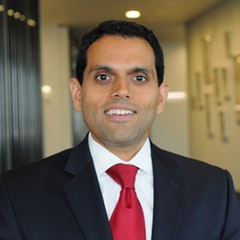This article is part of Carrier Management’s series on the Future of Insurance.
Dr. Henna Karna, Managing Director and Chief Data Officer, XL Catlin, answered Carrier Management’s questions about changes in the next decade by focusing on carrier journeys to set up robust data-digital foundations.
 Dr. Henna Karna, Managing Director and Chief Data Officer, XL Catlin
Dr. Henna Karna, Managing Director and Chief Data Officer, XL CatlinQ: What major changes do you see on the horizon for the property/casualty insurance industry in the next 10 years? What will insurance companies, insurance leaders, the industry and its workforce look like in the next decade? What risks will they insure?
Karna (XL Catlin): The agility of more recently stood up companies within our insurance/reinsurance world calls into question the prior perspective that this industry is not innovative or even disruptive due to our regulatory requirements. Like other corporate industries, property/casualty insurance and reinsurance is undergoing a spectrum of data and technology transformations, pushing forward changes in internal processes, customer/client partnerships, products and services, and ways of doing business that are now possible by digital.
To thrive, participants in the insurance industry—and every other industry—must embark upon a transformative journey toward establishing a robust data-digital foundation for every aspect of their enterprises or risk falling behind their competition. Digitally interconnected operations represent the most comprehensive, agile, innovative, creative and emotionally connected way of conducting business.
At the same time, this macroeconomic change makes possible a shift away from selling ever more goods and services to customers and instead focuses on adding the value those customers want and need—at the time of their want and need. Because they make a customer-centric approach possible, digital capabilities can restore a level of humanizing interaction between large enterprises with the individual touch points that have not been financially lucrative before or manageable with scale in the past.
In terms of risks, the world of complex risk will grow increasingly intricate, with our customers operating in a hyper-connected digital arena. This will present risks that are both familiar and unfamiliar to us today. As a result, companies—and the insurance industry—will be driven by their expertise in their internal and external data. Our insurance and reinsurance companies will become recognized as “data and analytics companies.” We will see the establishment of connected ecosystems that will advance our use of insights and foresights to drive critical decisions in real time.
Certainly, new risks will emerge for our insurance and reinsurance companies to insure. We have seen a few new risks accelerated with the IoT data and digital technologies. That said, it may be that insuring more variation of risk is more traditional in thought and that helping our customers profile their changing risks is where insurance and reinsurance companies head next.
The more successful companies will be able to change the model of selling insurance to partnering with their customers in a 24/7, bi-directional model to be more relevant to their decision-making on risk mitigation. Conversations will be backed up by historical trends and near-real-time information, tailored more specifically to relevant needs of customers.
Leaders and managers will need to understand how to self-service, analyze and discern information with speed and accuracy in a digital environment; evaluate trends and benchmarks while they enter the environments (not months later); and calibrate—or even redirect—go-to-market strategies as information becomes visible.
Our firms will be much less hierarchical, and there will be leaders at many levels of the organization who are empowered to positively impact the direction of the firm. Data science skills will become staple and organically grown. Career paths will go from ladders to lattices, and [companies] will have a unique opportunity to cultivate innovative data, analytics and technology skills across dozens of new capabilities.
Lastly, we will see our companies become more and more services-oriented as risk engineering, risk mitigation, and both consumer and commercial safety become more central to our value propositions.
Read more Future Insights by person
 Mike Albert, Co-Founder, Ask Kodiak
Mike Albert, Co-Founder, Ask Kodiak Tim Attia, CEO and Co-Founder, Slice Labs, Inc.
Tim Attia, CEO and Co-Founder, Slice Labs, Inc. Arun Balakrishnan, CEO, Xceedance
Arun Balakrishnan, CEO, Xceedance Ilya Bodner, CEO, Bold Penguin
Ilya Bodner, CEO, Bold Penguin Bobby Bowden, Executive Vice President, Chief Distribution and Marketing Officer, Allied World
Bobby Bowden, Executive Vice President, Chief Distribution and Marketing Officer, Allied World Andy Breen, Senior Vice President, Digital, Argo Group
Andy Breen, Senior Vice President, Digital, Argo Group Adam Cassady, CEO, Tyche Risk
Adam Cassady, CEO, Tyche Risk Chris Cheatham, CEO, RiskGenius
Chris Cheatham, CEO, RiskGenius Trent Cooksley, Head of Open Innovation, Markel Corporation
Trent Cooksley, Head of Open Innovation, Markel Corporation Mike Foley, CEO, Zurich North America
Mike Foley, CEO, Zurich North America Guy Goldstein, Co-Founder and CEO, Next Insurance
Guy Goldstein, Co-Founder and CEO, Next Insurance Mike Greene, CEO & Co-Founder, Hi Marley
Mike Greene, CEO & Co-Founder, Hi Marley Brian Hemesath, Managing Director, Global Insurance Accelerator
Brian Hemesath, Managing Director, Global Insurance Accelerator Russell Johnston, CEO, QBE North America
Russell Johnston, CEO, QBE North America Dr. Henna Karna, Managing Director and Chief Data Officer, XL Catlin
Dr. Henna Karna, Managing Director and Chief Data Officer, XL Catlin Tony Kuczinski, President and CEO of Munich Re, US
Tony Kuczinski, President and CEO of Munich Re, US Rashmi Melgiri, Co-Founder, CoverWallet
Rashmi Melgiri, Co-Founder, CoverWallet David W. Miles, Co-Founder and Managing Partner, ManchesterStory Group
David W. Miles, Co-Founder and Managing Partner, ManchesterStory Group Pranav Pasricha, CEO, Intellect SEEC
Pranav Pasricha, CEO, Intellect SEEC Mike Pritula, President, RMS
Mike Pritula, President, RMS Kathleen Reardon, CEO, Hamilton Re
Kathleen Reardon, CEO, Hamilton Re Jeff Richardson, Senior Vice President, OneBeacon Insurance Group
Jeff Richardson, Senior Vice President, OneBeacon Insurance Group Vikram Sidhu, Partner, Clyde & Co
Vikram Sidhu, Partner, Clyde & Co Christopher Swift, CEO, The Hartford
Christopher Swift, CEO, The Hartford Rebecca Wheeling Purcell, Schedule It
Rebecca Wheeling Purcell, Schedule It Keith Wolfe, President US P/C—Regional and National, Swiss Re
Keith Wolfe, President US P/C—Regional and National, Swiss Re

Get the responses of all 26 leaders neatly packaged in single PDF download. More than 43 pages of content.





















 AI Weather Models Promise Super Granular, Specialist Forecasts
AI Weather Models Promise Super Granular, Specialist Forecasts  The Workplace Is Changing; So Are the Risks for Employment Discrimination Claims
The Workplace Is Changing; So Are the Risks for Employment Discrimination Claims  The Future of the Insurance Customer Experience Is Unity, Personalization
The Future of the Insurance Customer Experience Is Unity, Personalization  Lemonade: 700K Customers on the Car Waitlist
Lemonade: 700K Customers on the Car Waitlist 




